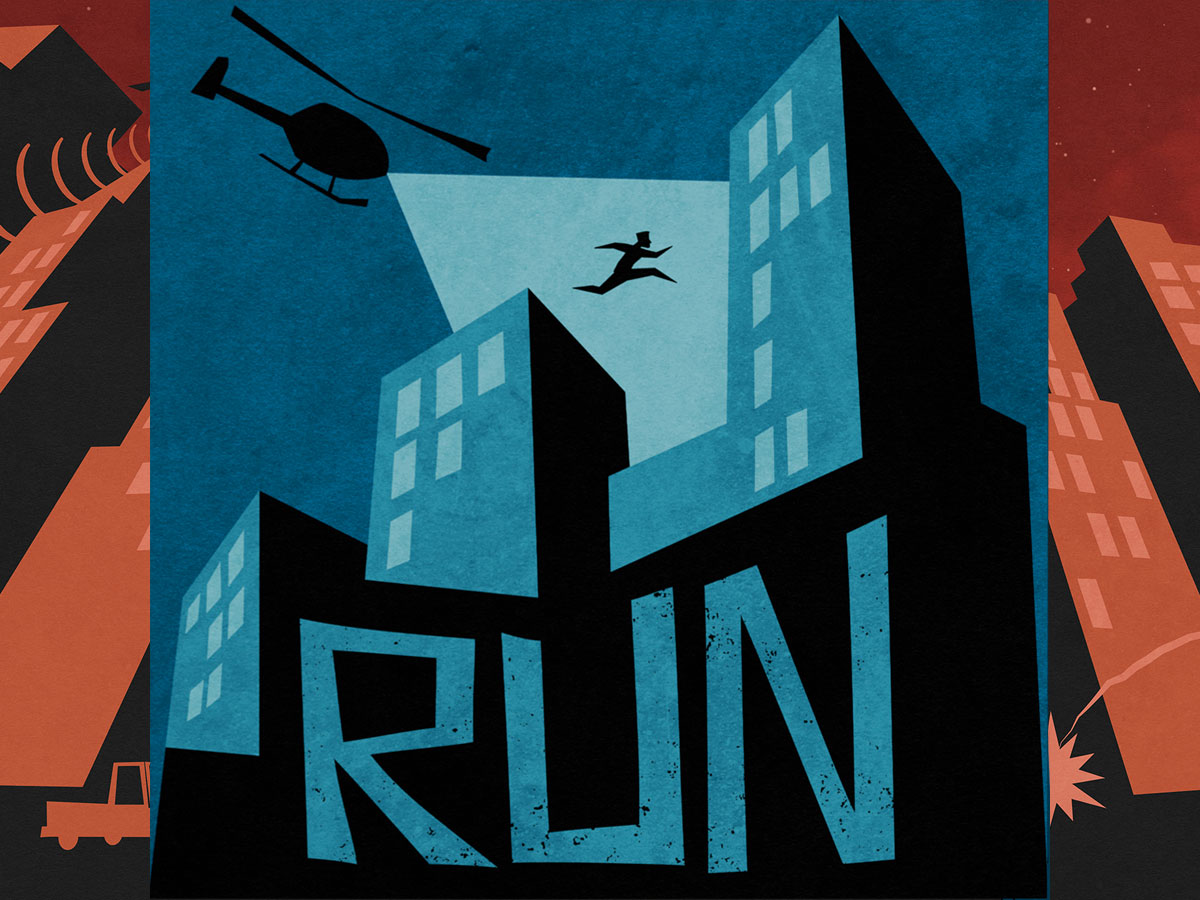You’re on the run—gotta hit your stashes, and then make it to the safe-house before that dispatcher tracks you down!
What Is RUN?
RUN is a hidden movement game for 2 players, ages 14 and up, and takes about 30 minutes to play. It’s currently seeking funding on Backerkit, with a pledge level of $33 for a copy of the game. The game has a theme of a character running from (presumably) law enforcement, but the story isn’t very detailed; I think you could play with kids younger than 14 but it’s definitely the sort of game where being able to read the other player gives you an advantage. (Note that the Backerkit campaign also includes a new edition of another cat-and-mouse title from Fowers Games, Fugitive; you can pledge for both games together for $50.)
RUN was designed by Moritz Dressler and published by Fowers Games, with illustrations by Ryan Goldsberry.
New to Backerkit? Check out our crowdfunding primer.
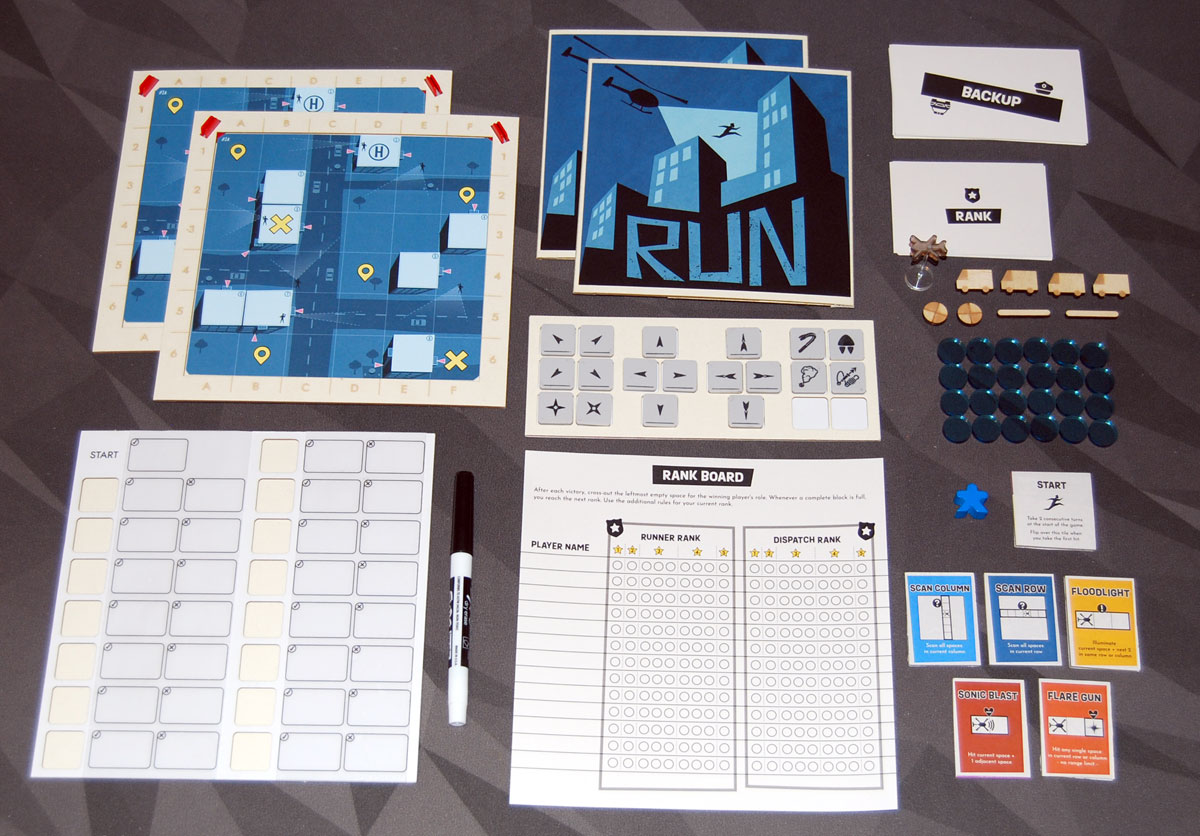
RUN Components
Note: My review is based on a prototype copy, so it is subject to change and may not reflect final component quality. Components may be added or upgraded based on stretch goals.
Here’s what currently comes in the box:
- 2 Custom Screens
- 2 Double-sided maps (4 playable maps)
- Rank board
- 6 Rank cards
- Runner figure
- Runner action board
- Runner status tile
- 14 Runner action tokens
- 4 Gadget tokens
- Dispatch helicopter figure
- 5 Dispatch action cards
- 24 Dispatch tracking disks
- 8 Dispatch backup cards
- 8 Backup punchboard tokens
- Evidence board
- Dry erase marker
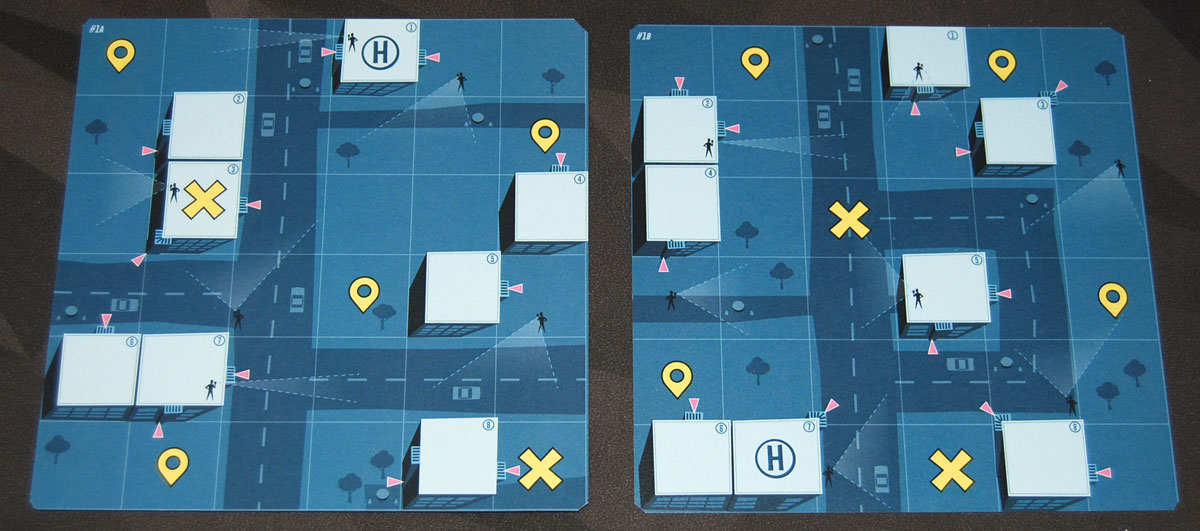
My version of the game was a prototype, so it was a mix of finished artwork and placeholder artwork, with a lot of substitutes for final components. (You may notice that we used a Totoro meeple as our Runner.) The artwork in the finished game will be by Ryan Goldsberry, who illustrated other Fowers Games titles like Fugitive and Burgle Bros, and I’ve always liked this fun, retro style that gives off Ocean’s Eleven vibes. In Run, there will be player screens that show a city skyline (similar to the box cover), and the map itself is a top-down view of a city with a few fun details sprinkled throughout.
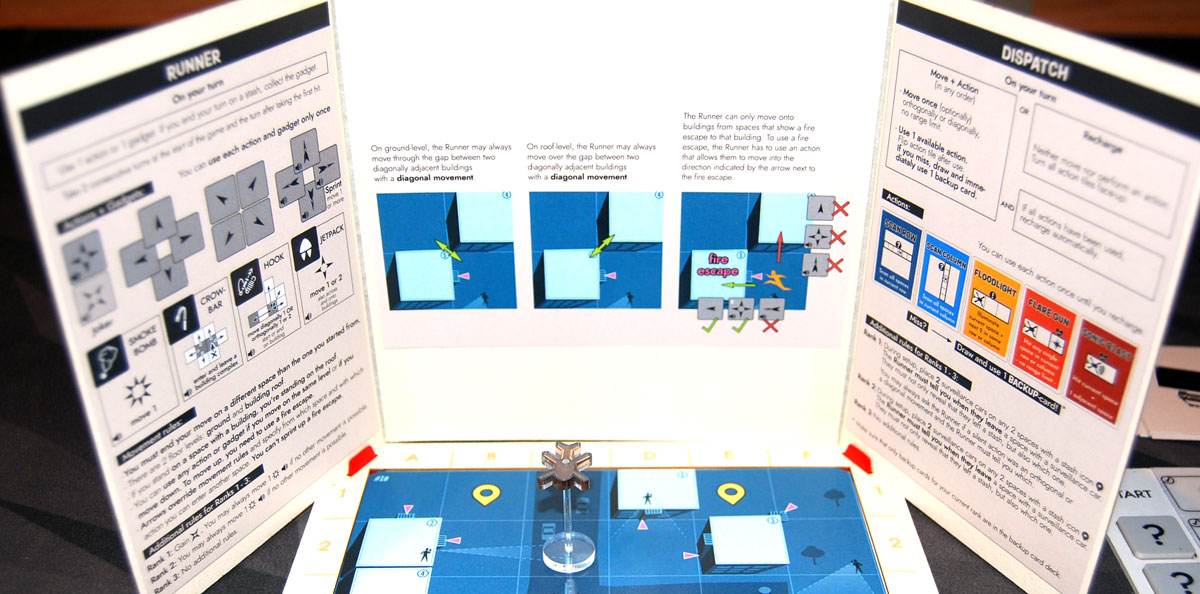
The Runner’s action tokens fit into the dual-layered action board, and as they’re spent they also slot into the evidence board, which has some dry-erase sections for the Dispatcher to take notes. There are various tokens that are placed on the map, so they’re fairly small to fit onto the allocated spaces.
How to Play RUN
You can download a draft of the rulebook here. There will be a print and play to try, made available on September 1.
The Goal
The Runner is trying to reach 3 stashes and then make it to a safe-house. The Dispatcher is trying to hit the Runner twice before then.
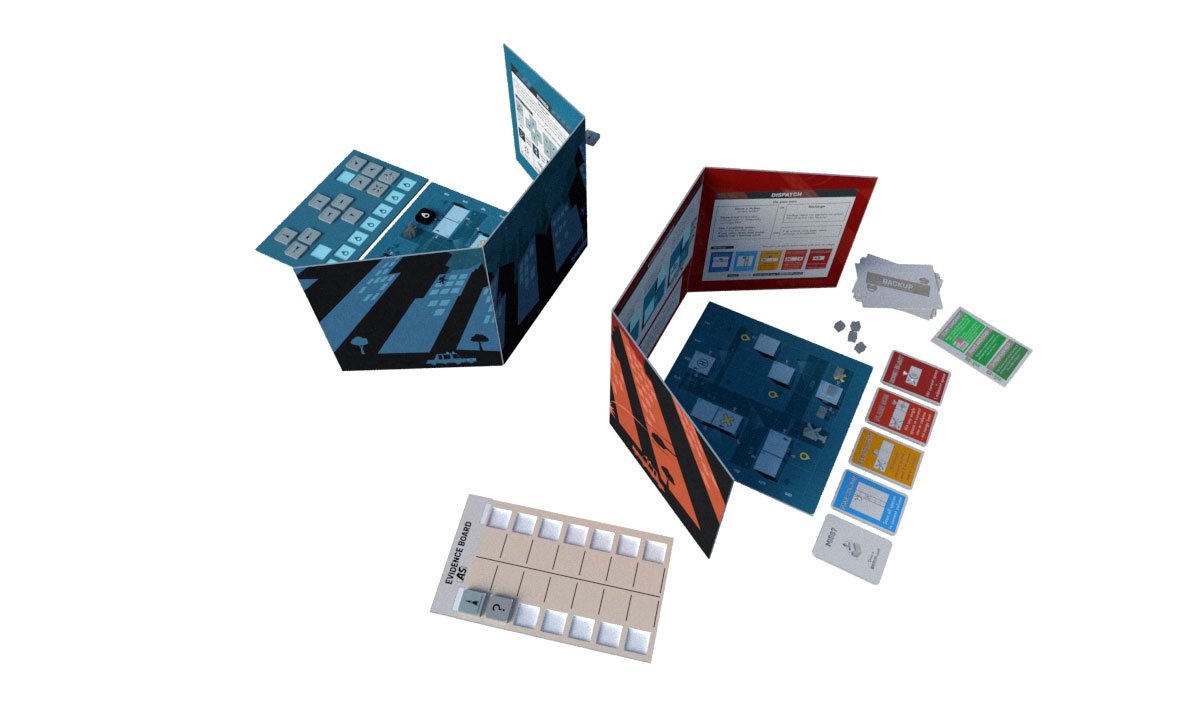
Setup
Give each player a map and a screen (be sure each player is using the same map).
When you first play the game, you start at Rank 1, and you work your way up when you win the requisite number of games (tracked on the rank board). Each player takes the appropriate rank card, which may have additional setup instructions or rules. For instance, at Rank 1 the Runner gets a diagonal joker action tile, and the Dispatcher gets to add two surveillance vans to the board.
The Dispatcher takes the helicopter figure, dispatch action cards, backup cards matching their current rank, and evidence board. The helicopter starts on the helipad space. Shuffle the backup cards and draw 1—the number at the top indicates the Runner’s starting location on the map. Then reshuffle the backup cards.

The Runner takes the runner figure and the action board filled with the action tokens, as well as the status tile set to the “Start” side. Make sure the action board is behind the screen so the Dispatcher cannot see it. Shuffle the gadget tokens and place one face-down on each stash location. Place your figure on the starting location designated by the Dispatcher.
Gameplay
At the start of the game, the Runner will take two consecutive turns. The first time the Runner is hit by the Dispatcher, they flip the status tile over to the “Hit” side and take another two turns in a row.
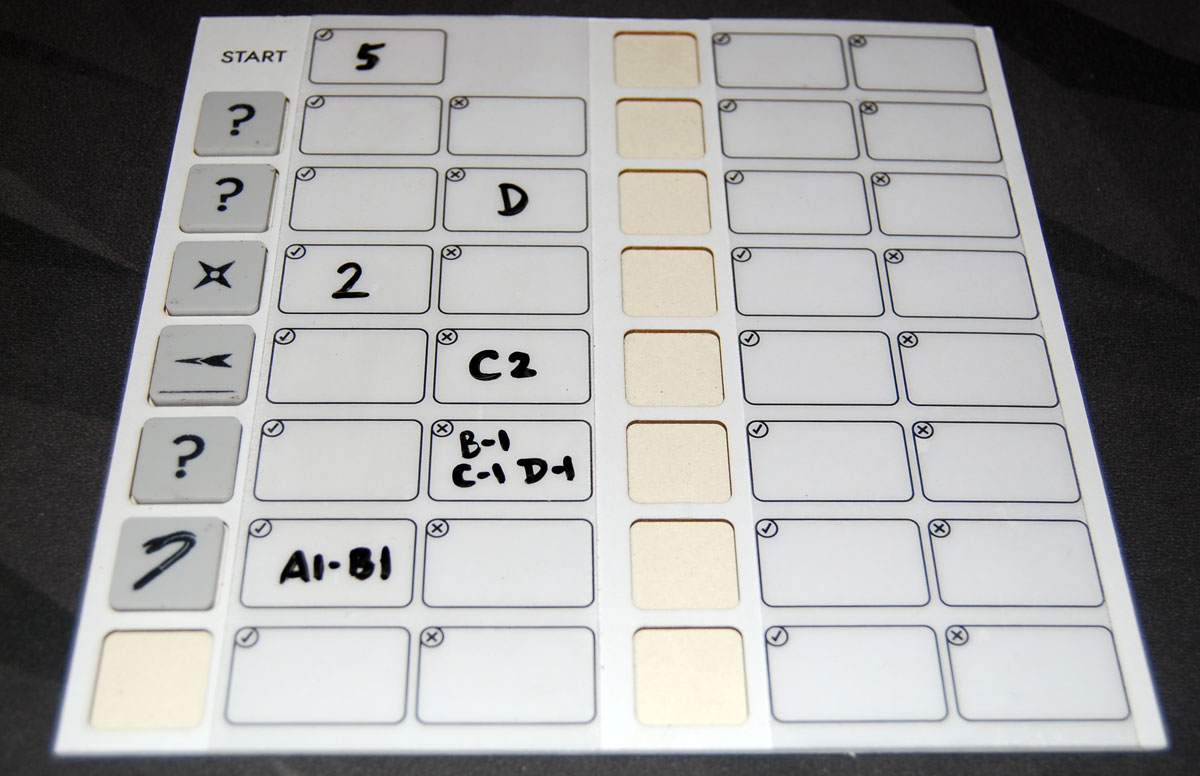
The Runner has action tokens allowing them to move in different directions—each time they move, they move the token to the Dispatcher’s evidence board. Some movements (most of the single-space movements) are quiet, so the token is placed face-down. Others are loud—the token has the same icon on both sides—so the Dispatcher knows which token is used.
The Runner can hop down from rooftops in any direction, but can only get onto a roof by using a fire escape, moving in the directions marked by arrows. The Runner has four “sprint” tokens that allow them to move any number of spaces in an orthogonal direction, but they cannot use fire escapes during a sprint.

Each time a Runner enters a stash space with a gadget, they claim that gadget token and add it to their action board. There are four gadgets that help the Runner move around: for instance, the jetpack lets the Runner ignore building heights when moving. Each gadget may only be used once, and is then placed on the evidence board for the Dispatcher to see.
The Dispatcher may optionally move their helicopter any number of spaces in a straight line (orthogonally or diagonally, like a queen in chess), ignoring buildings. Then they must either use one of their 5 action cards (flipping it face-down), or recharge to flip all action cards face-up. (If you use your last action card, they recharge automatically.)

The Dispatcher has 3 actions that help it locate the Runner: for instance, Scan Column will check if the Runner is in the same column as the Dispatcher. The Runner only answers “yes” or “no” but doesn’t give their exact position. The Dispatcher also has two actions that can hit the Runner, a Sonic Blast and a Flare Gun.
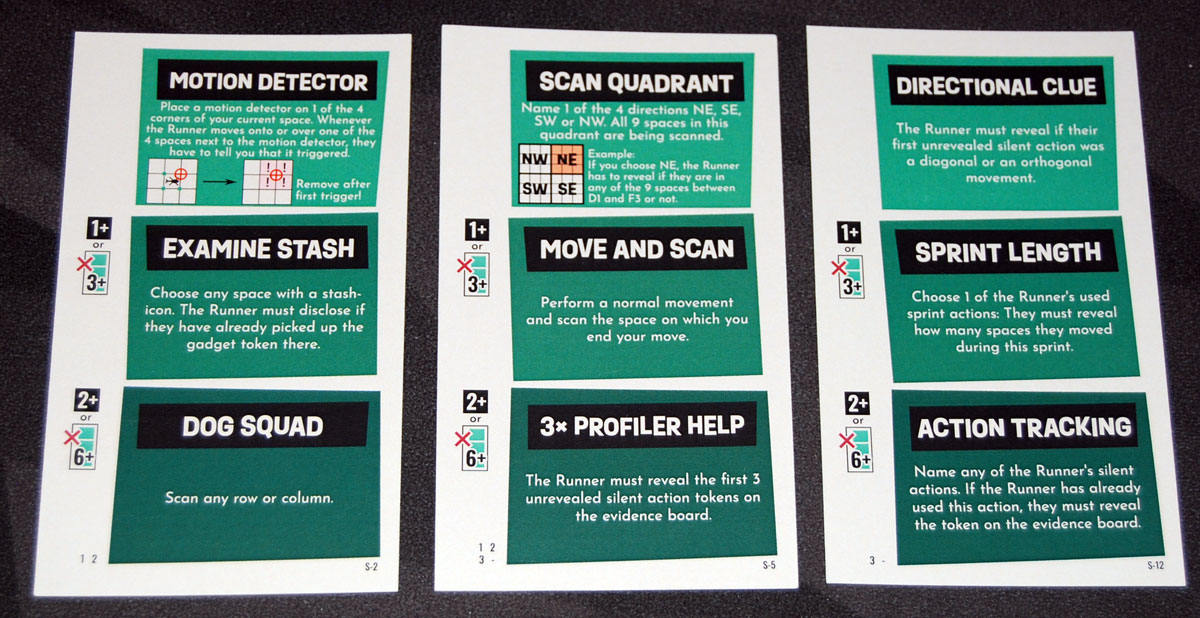
If the Dispatcher’s action misses the Runner, they draw a backup card and use one action on it. Each backup card has three actions printed on it; the actions available to you depend on how many gadgets the Runner has used and how many backup cards you’ve already played. Backup cards may let you move around, scan spaces, set roadblocks or motion detectors, and other helpful effects.
Game End
If the Runner picks up 3 stashes and ends their movement on a safe-house, the Runner wins the game. If the Dispatcher lands two hits on the Runner, the Dispatcher wins.
Why You Should Play RUN
I’m a fan of hidden movement games—I enjoy both the challenge of trying to stay one step ahead of my pursuer and piecing together clues to figure out where my target is hiding. I recently played Mirror’s Edge on the Xbox (I know, I’m late to the party) and it was fun to pretend RUN was set in that world: you gotta keep running to stay alive, and there are helicopters (or drones) trying to chase you down.
Although the storyline of RUN is fairly similar to Fugitive, the game that it’s paired with in this Backerkit campaign, the gameplay is quite different. Fugitive is more of a logic puzzle along a number line; RUN adds a second dimension and new tools for both the Runner and the Dispatcher. In fact, RUN reminds me a bit of another Fowers Games title, Sabotage, but in a smaller package and a bit easier to dive in. Both games are asymmetric, with one person hiding and one person seeking, and they have some similar tools for trying to track down their sneaky suspects. That may be where the similarity ends, though.
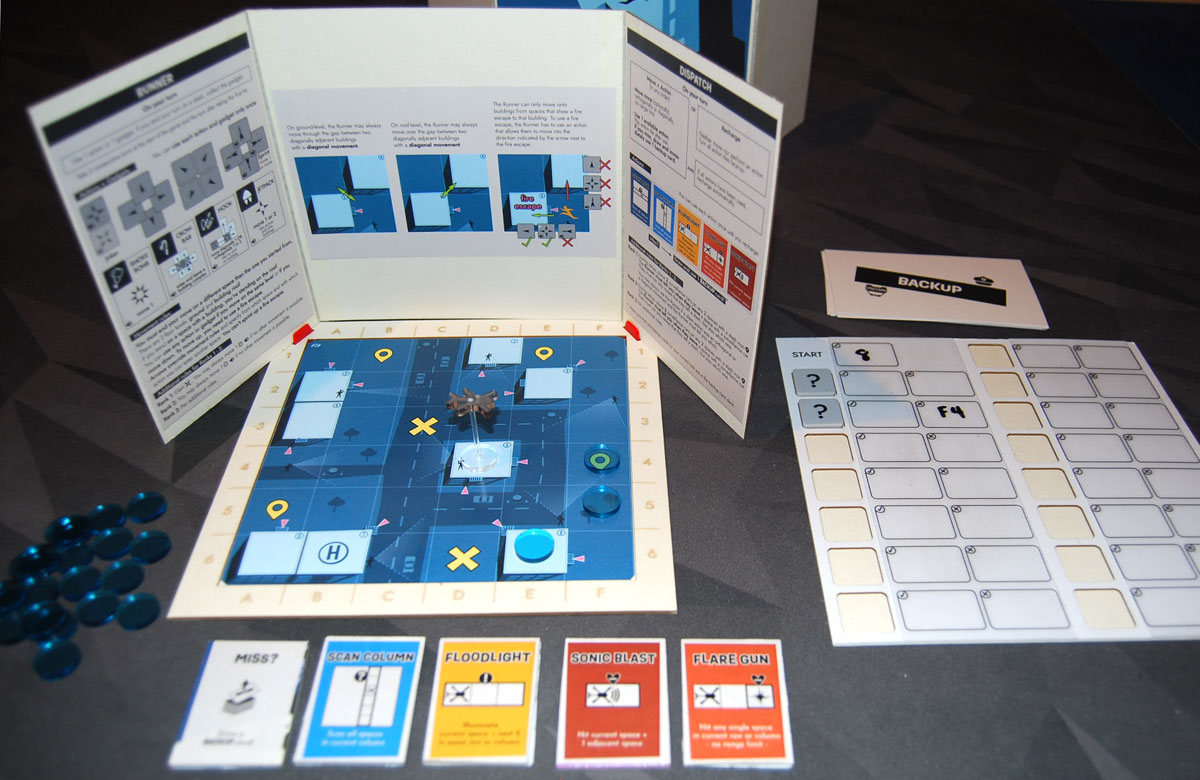
In RUN, the Runner has a limited number of moves, represented by the tokens. If you move to the left one space, then you’ve spent that token and can’t use it again. You do have one orthogonal joker tile so you could use that to move left, and you do have a “sprint left” token as well, but both of those are loud and give the Dispatcher more information. You have to figure out how to get from your starting location to three different stashes and a hideout essentially without repeating a move, all while staying hidden from the Dispatcher and managing the restrictions for fire escapes.
The gadgets do give you a bit of relief: the grappling hook lets you get up onto or down from a building more quickly (and without worrying about fire escapes), and the crowbar lets you run through a building complex and exit from any side. The last gadget, the smoke bomb, lets you move one space in any direction—could be really useful for getting out of a tight spot!
On the flip side, the Dispatcher has the backup cards, and the better the Runner is doing, the more powerful the backup cards become. The second option on the backup card is available after the Runner has used one gadget or the Dispatcher has discarded 3 backup cards. The last option opens up when the Runner has used three gadgets (and is therefore making a dash for the safe-house!) or when the Dispatcher has discarded 6 backup cards. I don’t know if it’s worth using a strategy of intentionally scanning the wrong spaces to miss the Runner simply to play more backup cards.
The evidence board is an easy way to track what you know—you have an ongoing record of the Runner’s actions (even if many of them are quiet and you don’t know exactly what they are), and you can also mark down if you spotted the runner with a scan or eliminated a space as a possibility. The rules don’t explain how to use the tracking tokens exactly, but you can use them to mark where you think the Runner might be or their potential path through the city. As you narrow down the Runner’s path through the city, you can also start predicting where they can go based on which movement directions they have left.
Because the board is fairly small (a 6×6 grid) and the helicopter can move any number of spaces, the Runner can’t really outrun the Dispatcher. It’s more a matter of outsmarting them, because no matter where you are on the board, the Dispatcher can probably reach you, as long as they have the right action available. Meanwhile, the Dispatcher has a broad reach, but has to be judicious about when to use each action. It feels the most efficient to use all five and get the free recharge, but only two of your actions can attack the Runner. Your scanning covers a large area but you don’t get a precise answer; your attacks only hit 1 or 2 squares, so you can’t afford to miss.
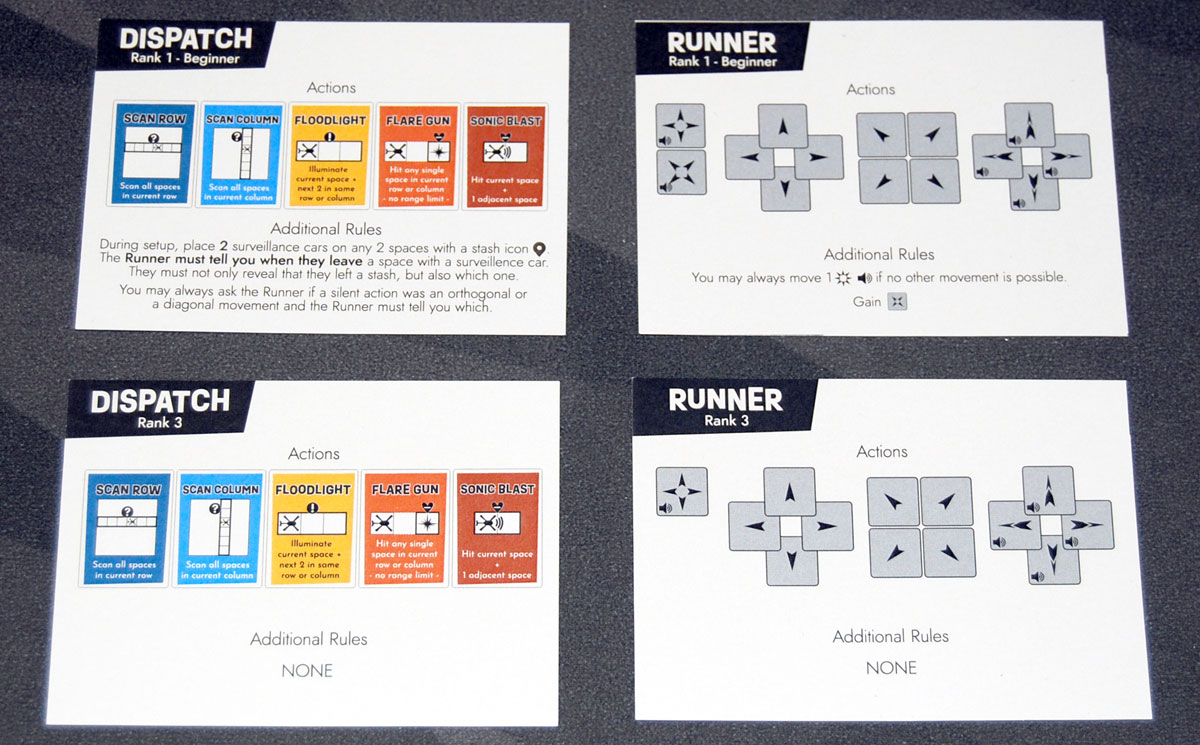
The prototype I played had three ranks available. For the Runner, at lower ranks if you run out of moves, you can still move a single space in any direction but you have to announce it to the Dispatcher—once you graduate to the higher ranks, though, you’ll lose if you can’t run anywhere. For the Dispatcher, the lower ranks give you some extra tools: the surveillance vans trigger an alert when the Runner leaves their spaces, and you can also ask whether a quiet move was orthogonal or diagonal. At higher ranks, the Dispatcher loses these benefits. Depending on how the campaign does, there are more ranks planned, which is a neat way to balance out the game play when experience levels aren’t matched.
I’ve enjoyed my plays of RUN so far, both as Dispatcher and Runner. I’m interested to see how the higher ranks will tweak the game, but it’s a solid cat-and-mouse game even with just the prototype rules. The fact that it is only for 2 players is a slight downside because I often have more than 2 players at my game nights, but that’s just a personal preference. I’d encourage you to check it out if you like hidden movement games.
For more information or to make a pledge, visit the RUN Backerkit page!
Click here to see all our tabletop game reviews.
![]() To subscribe to GeekDad’s tabletop gaming coverage, please copy this link and add it to your RSS reader.
To subscribe to GeekDad’s tabletop gaming coverage, please copy this link and add it to your RSS reader.
Disclosure: GeekDad received a prototype of this game for review purposes.
